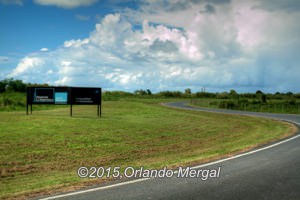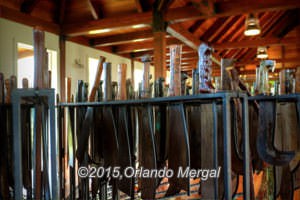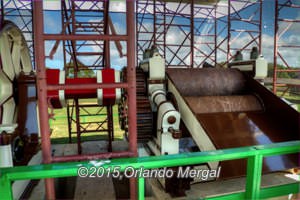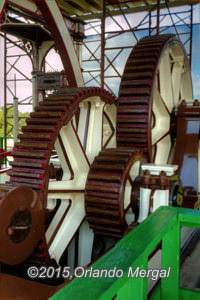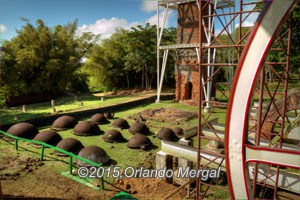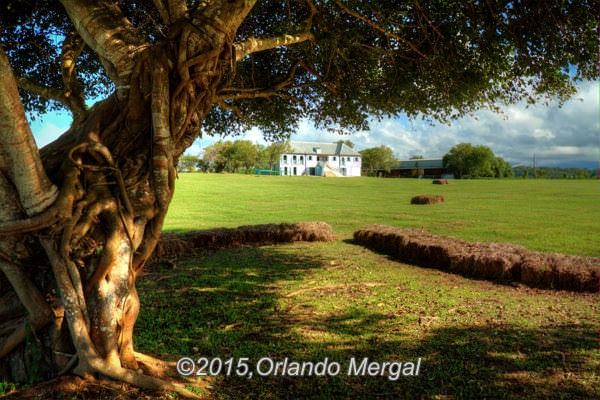
La Casa Del Marquez, Hacienda La Esperanza, Manatí, Puerto Rico
Back in February of 2014 we visited “Las Cabezas de San Juan”, a 438 acre nature reserve run by the Puerto Rico Conservation Trust (Fideicomiso de Conservación de Puerto Rico). This time my wife and I headed west towards the town of Manatí to visit Hacienda La Esperanza, a 2,220 acre property that was once a thriving sugar hacienda.
Hacienda La Esperanza is also run by the Puerto Rico Conservation Trust, and the experience this time was just as delightful.
Visitors must make reservations in advance. No walk-ins are allowed. I understand why they do this, but I also find it self serving in terms of customer service. Furthermore, I find their website cumbersome and confusing. If you don’t show up you’ll lose your money. Entrance fees vary per tour. We paid $12 per visitor plus a 7% tax.
In any case, the Puerto Rico Conservation Trust’s URL is: https://reservaciones.paralanaturaleza.org/index.jsf and their telephone number is 787–722-5882. You can also call the Hacienda directly at 787–854-2679 for more information and directions.
Other than these minor issues with their website the experience was a blast!!!
We were instructed to arrive at 1:00pm for a tour that was scheduled to start at 1:30pm. We were also provided with releases that every visitor must sign before embarking on the tour.
Zoraida and I arrived exactly at 1:00pm. A few minutes later our guide José arrived and introduced himself. He was a young and pleasant man who proved to be quite knowledgeable throughout the tour. The tour started at exactly 1:30pm with one guide and a party of six.
Hacienda La Esperanza is the largest property owned by the Puerto Rico Conservation Trust and, like its sister property in Fajardo, it is considered a natural reserve. However, that’s where the similarities end. Hacienda La Esperanza was one of Puerto Rico’s most important sugar haciendas during the 19th century.
The 19th century was peppered with economic ups and downs that had a direct effect on the Island’s social and economic realities. In Europe, the Napoleonic Wars affected the movement of ships towards the colonies, which in turn had a negative effect on the movement of merchandize back to Europe. This made it harder for the Spanish crown to collect taxes.
In 1815 King Fernand the VII of Spain signed the Royal Decree of Grants (Real Cédula De Gracia) which allowed the Spanish colonies to trade with other European countries as well as with the United States. This brought prosperity back to the colonies because it opened new markets; and —of course— it allowed the crown to collect its taxes. It also allowed for the influx of tax-free machinery and tools which modernized production, increased efficiency and resulted in greater profits for the sugar barons of the time.
In Puerto Rico the 19th century was all about sugar and Hacienda La Esperanza was one of the places where it all happened.
During the first decade of the 19th century a retired Spanish soldier by the name of Don Fernando Fernández arrived in Puerto Rico. He became a slave trader and lived his first years on the Island in the city of San Juan. However, the economic downturn caused by the Napoleonic Wars was putting a dent in his business.
In 1827, after the Royal Decree of Grants, don Fernando saw the opportunity to develop a plot of land that he had received from the King of Spain in the town of Bayamón, about 25 west of San Juan. He established Hacienda Santa Ana, a sugar hacienda that produced “Ron El Barrilito”, which is still considered one of Puerto Rico’s best rums today.
Business was booming and Don Fernando decided to expand his operations. He started exploring the north central region of the Island and arrived at the area that would eventually become Hacienda La Esperanza. The land was humid, flat, fertile and next to a river. This guaranteed natural irrigation as well as a means of transportation for his products.
The exact year when Don Fernando established Hacienda La Esperanza is not clear but it appeared in the 1840 edition of the Manatí Register of Haciendas; so it was established sometime during the 1830’s.
Our first stop was at “La Casa Del Marquez” (the house of the Marquez). Marquez was a Spanish nobility title that was below duke and above earl (more about why it was called this way in a while).
“La Casa Del Marquez” is an example of the opulence that characterized the families that traded in sugar, coffee and slaves during the 19th century in Puerto Rico. The building itself isn’t an original. That one was destroyed by Hurricane Georges in 1998. But it’s an exact replica made with different materials.
Luckily, the Puerto Rico Conservation Trust hired an architect back in 1976 to produce detailed drawings of the original structure. Later on, when it was destroyed, it was those drawings that allowed them to bring it back to its original splendor. Even so, there were certain wood species used in the original structure, like “moralón”, “ortegón” and native mahogany that are protected today. So instead the actual version was built with “capá prieto” for ceilings and floors, pine for interior and exterior siding and cedar for windows and doors.
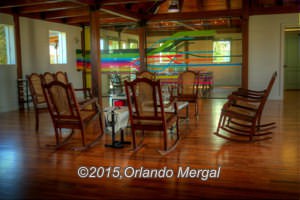
Interior of La Casa Del Marquez. Check out the “ausubo” columns. Click on image to see it larger.
And there’s still another feature that you shouldn’t miss. Take a look at the building’s columns. They’re made of ausubo, a wood so hard that you have drill it first before driving a nail into it.
Other interesting features inside “La Casa Del Marquez” are a collection of 389 machetes and a “paño de querellas” (cloth of complaints) that was donated by a group of weavers from the town of Moca on the western coast of the Island.
Machetes were the tool of the trade in a 19th century sugar hacienda. But not all machetes were created equal. The longer ones were called sables and they were used by the people in charge of “supervising” the slaves. The shorter ones (called mochas) were used by the slaves to prevent them from hurting each other accidentally and from using them as weapons during a possible rebellion. Finally, the curved variety was used in combination with a “garabato” (hook-shape piece of wood) to cut the “pangola” grass that grew next to the sugar cane.
None of the machetes that you’ll see at Hacienda La Esperanza were the originals used by the slaves. However, they are original pieces collected by Puerto Rican archeologist Ovidio Dávila throughout the Caribbean. They are exactly like the ones used by the slaves back in the 19th century.
Back in the 1800’s life was pretty tough for slaves living in sugar haciendas. They lived in barracks, slept on the floor, bathed once a week and did their necessities in a whole in the barrack floor. The stench was so bad that the building was erected down wind from “La Casa Del Marquez”.
The king of Spain was well aware that there had already been a slave rebellion in Haiti between 1791 and 1804. Some countries were against slavery and others –like Spain— considered it perfectly “normal”. So in 1826 the king created something called “el lamento” which established the exact rights and obligations for both slaves and slave owners.
If a slave felt like his “rights” had been violated he could bring the matter before the town major, who would listen to both parties and decide who was right. Of course, most of the time the slave owner would be “right”, which is why the “paño de querellas” contains the only five complaints filed against Hacienda La Esperanza. And just to give you a little taste of what it was like to be a slave during 19th century Puerto Rico here’s a short list of a slaves “rights”:
- Two meals a day
- Three changes of clothes a year
- If a female slave became pregnant her baby would automatically be born a slave
- The baby’s first name would be a catholic name
- His/her last name would be his master’s
- At the age of six he/she would start working
- If a slave reached the age of 60 (which very few did) he/she would be granted freedom
Across a plot of land, about 100 yards long, is where the hacienda’s sugar mill (trapiche) was located.
Hacienda La Esperanza was a model of efficiency from the very beginning, albeit for a variety of reasons. The original hacienda had a blood sugar mill (trapiche de sangre). Some historians say that it was called that way because sometimes the slaves would get their arms caught in the rollers. However, our guide José insisted that the real reason was because it was powered by slaves and oxen and not by any alternate form of energy.
José insisted that the later steam operated sugar mill could just as well be called a blood sugar mill because slaves got their arms caught in that one as well.
So, if the original sugar mill was powered by oxen and slaves, what made the original hacienda so efficient. It was the sugar cane itself. The sugar cane planted at Hacienda La Esperanza was brought all the way from the Island of Tahiti in the Pacific ocean. It was called “Otaheiti” and it had three very important characteristics:
- Better yield (between 1/4 and 1/3 more)
- Better burning bagasse (it burned better and hotter)
- It matured quicker, which allowed for more sugar crops a year
During the 1850’s the United States and Europe entered the sugar market. The United States made it out of Maple trees and Europe out of sugar beets. This saturated the market and brought the price of sugar down. The only way to compete in such a market was to reach greater efficiencies and that’s exactly what happened at Hacienda La Esperanza.
But it was not Don Fernando who took the operation to the next level. It was his son José Ramón Demetrio Fernández y Martínez (remember him?). José Ramón was an educated man who had studied business administration in New York and London. He was also willing to “bend the rules” every once in a while to achieve his objectives.
During the 1860’s he took over the hacienda and quadrupled production. How did he do that? Well, the first thing that he did was to get a loan from a bank in London. With that money he did two things: he bought a small pier on the delta of the “Río Grande de Manatí”, on the northwest corner of Hacienda La Esperanza. Then in 1861 he travelled to New York and bought a brand new steam-operated sugar mill. Finally he had the pieces of the sugar mill delivered to his private port, brought up river to the hacienda and secretly assembled inside his production building. Oh, and he didn’t pay any taxes for the machinery either. What a guy!
The new mill not only produced four times the yield but it also extracted all the juice from the sugar cane in one pass. This resulted in drier bagasse that burned better.
In 1869 the hacienda was doing so well that Don Ramón was awarded the title of “Marquez De La Esperanza”, which is why the huge house on the property is called “La Casa Del Marquez”.
Sugar production at Hacienda La Esperanza was a unique process in which nothing was wasted. Once the sugar cane went through the mill you were left with two byproducts: cane juice and bagasse. The next step was called the “Jamaican Train”.
The truth is that it wasn’t actually a train. It was called that way because it consisted of a series of kettles (peroles) that decreased in size and the process was invented in Jamaica. The “Spanish Train” which preceded it used one furnace under every kettle while the “Jamaican Train” used one furnace underneath the smallest kettle and a duct that distributed the heat to all four kettles. This resulted in a more efficient use of the bagasse.
The cane juice would be poured into the furthest and largest kettle where it was brought up to a boil. Once some of the water had evaporated the resulting syrup would be move to the next kettle using giant spoons. This process would go on until the syrup reached the last (smallest) kettle and became molasses. From there it was removed and placed in giant cones where it was left to cool off and become muscovado sugar (raw sugar).
Of course, this last stage had its own perils. Hot juice would frequently drip from the giant spoons burning the slave’s arms and legs. That is why, even with all the hardships that came with cutting sugar cane in the fields, the slaves preferred it to working in the sugar mill or at the Jamaican Train.
During its golden era in 1870 Hacienda La Esperanza had 152 slaves, but in 1873 slavery was abolished in Puerto Rico and that spelled the end for the hacienda in 1880. By then José Ramón had taken up gambling and he lost a great deal of his fortune. The rest was seized by the bank that loaned him the money for the sugar mill.
Our tour ended at the Jamaican Train and we headed back to the parking lot. On the way back there was something that caught my attention. It was the absolute silence. I could just imagine what that place must have been like back in the 1800’s and now you could barely hear an occasional bird.
This is truly a place that everyone should visit. Not only because it puts a lot of things that we usually take for granted into perspective, but because it gives us a rare glimpse into what life was like just a century and a half ago. Besides, the steam operated sugar mill at Hacienda La Esperanza is in perfect operating order and it’s the only one of its kind left in the world!
Once again my hat goes off to the Puerto Rico Conservation Trust (Fideicomiso de Conservación de Puerto Rico). Zoraida and I loved it!!!
©2015,Orlando Mergal, MA
____________________
Bilingual Content Creator, Blogger, Podcaster,
Author, Photographer and New Media Expert
Tel. 787–750-0000, Mobile 787–306-1590

